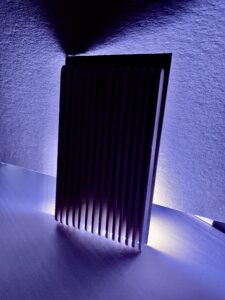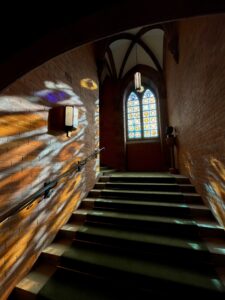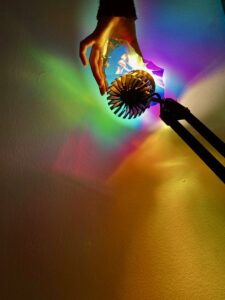- Natural light is personal, connects humans with their environment and is associated with memories
- Daylight is different to sunlight
- Twilight is more dramatic
- Adding artificial light accentuates the viewers experience
- Hidden LED strips balance the light through the space and intensifies the twilight
- Sunlight moves throughout interiors during the day and creates movement, highlights elements in the space and gives each visitor a different experience every time
- Sunlight is is location and time specific
- Ceiling windows can allow daylight in while blocking sunlight to manipulate the room in order to provide different nuances for different types of interiors
- “Light, in all its subtle modulations, is exhilarating; the stuff of life itself made vivid to us by the surface it falls upon” Lyndon in Levinson 1995
- Architectural designers can use daylight to positively modify the experience of the inhabitant
- Can enhance the experience of a space
- We are starting to lose an understanding of daylight and sunlight due to the availability of a switch that can light a space. We are losing the skills of working with the subtleties of daylight.
Evidence based lighting design
Example – Older hospitals would have faced patients beds at an angle that they would get daylight and sunlight throughout the day but that is forgotten in the architecture of new hospitals
A lot of the new hospitals are filled with artificial light
The quality of light
If we look at daylight coming from in from a west facing window and then from a north facing window, we would find a cooler colour of daylight coming through the north facing window
Kelvin rating – the higher the number, the cooler the light
During the morning, the increasing light, usually daylight, signals the body clock that it should begin its active cycle. The body responds by producing cortisol. Throughout the day, our cortisol levels rise until noon. It starts to drop off during the afternoon which may be known as a ‘post lunch dip’. As the daylight signals fade, the body cuts back on active energetic hormones and within a few hours the body temperature begins to fall and we begin to wind down. As daylight continues to diminish the dim light ‘melatonin onset’ occurs. As the body clock increases melatonin and other sleep hormones our temperature continues to drop and our bodies go into hibernation response, ready for sleep. The active exposure to light can effect melatonin levels that we have in our bodies.
A sustainable agenda
- Daylight in a free sustainable source of light
- As artificial lighting is becoming more efficient, lumen is increasing
- Efficacy – the number of watts going into powering that lamp in relation to the lumens and the amount of light we get out of the lamp
- LEDs are set to revolutionise the energy efficiency of lighting
- The traditional incandescence light offered 12 lumens per watt and a life of about 1000 hours
- That can now be replaced by an LED lamp exceeding 100 lumens per watt and 35000 hours of use or more
Quantifying daylight
Lighting metrics; used to identify lighting levels and the amount of different metrics that we have relate to that
Illuminance is measured in lux (E); relates to the amount of light that lands on a surface per square meter. This may be known as the working plane. The working plane itself may change depending on the height that you are calculating for e.g. a yoga studio is different to an art studio.
Luminance the light we see that bounces off the material and into the eye.
Daylight factor
DF = EI (indoor daylight illuminance) X 100%
EO (outdoor daylight illuminance)
Dynamic DF = E inside (100 lux) X 100% = 0.02 (x100) = 2% DF
E Outside overcast sky (5000 lux)
- Sometimes we have to predict this
- Daylight factors consider the sky, the internal reflective values of your inside space
- However, it doesn’t consider the fact you may have some glazing orientated to the north and some glazing is orientated to the south and that makes a difference to the amount of light that we are getting into that space
- It also doesn’t consider funny skies/clear sky conditions
Britain has overcast skies for over 80% of the days in the year
sDA
- Special daylight autonomy; whether a space receives enough daylight during standard operating hours on an annual basis using hourly illuminance grids on the horizontal work plane.
- More accurate as we use a computer system
Daylight – 3 rules of thumb
- No sky rule – draw the section of the building, put someone in it and when you get to an area where you can no longer see the sky because of obstructions then you can predict at what point you need to bring in artificial light – don’t forget about external obstructions
- Take the height of the window and then take and height and place it on the plan horizontally and multiply by 1.5.
- Consider ceiling height of the space on section which will help with placing skylights so roof lights within that space should be approximately 1.5 between them of that ceiling height
- A 1m squared skylight brings in 3 times the amount of light that a vertical window would give.
- Of course with a skylight you don’t get a view so you figure out a balance depending on the situation that youre in.
- Not just the area of glazing but the type of glazing is just as important to let daylight in
“So this is a kind of invention that comes out of the desire to have natural light. Because it is the light the painter used to paint his painting and artificial light is static light where natural light is a light of mood. The painting must reveal itself in different aspects if the moods of light are included in its viewing, in it’s seeing. I think that’s the nature, really, of a place where you see paintings.”
Using daylight for atmosphere and sunlight to enrich a space
Getting the location of the sun right is very important
Specular surfaces
- Interior materials can be effective in creating an atmosphere within the space
- What might be a white space can become a very coloured space and transient with the colour. As the sun moves, the trace of the colour moves across the room creating beautiful effects
Solar control
- can define how the interior of a space can feel like
- can be very technical
- Aesthetic and visual language
- Sustainability, operation and cost
- Thermal technology suggest external shading device as far away from glazing as possible as this allows shading device to cool in external air and solar gain is reduced as it is diverted prior to absorption into the glazing




